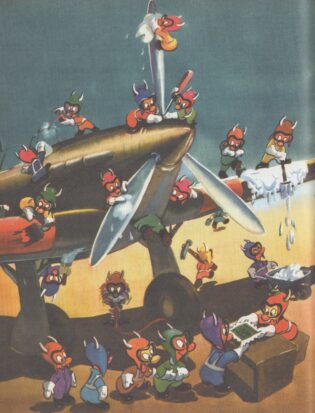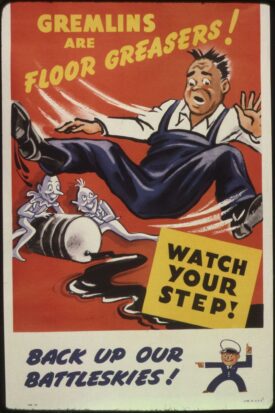
Gremlins on Board

This column is a reprint from Unwinnable Monthly #158. If you like what you see, grab the magazine for less than ten dollars, or subscribe and get all future magazines for half price.
———
Architecture and games.
———
Gremlins came out on June 8, 1984, to critical and commercial success, but well before there was the movie, there was the real thing. I’m of course talking about the little monsters that tear apart airplanes whenever pilots aren’t looking.
You probably aren’t aware of the etymology, but the word gremlin comes directly from aviation. This goes all the way back to World War II, at which point the term was used to describe the largely unexplainable mechanical malfunctions affecting various aircraft systems. Think along the lines of dead batteries, hydraulic leaks, popped fuses or even flat tires. Those little problems that turn up quite literally overnight. The reality was that pilots and mechanics were simply passing the buck for what most likely amounted to negligence, but these mechanical malfunctions were blamed on gremlins, mischievous creatures that make a mess out of machinery. The word first came into common usage among pilots of the Royal Air Force that were stationed in bases throughout the Near and Middle East. The earliest printed record happens to be a poem dated to April 10, 1929, that was published in the magazine Aeroplane.

Pilots have been complaining about gremlins ever since there have been airplanes and I can attest to the fact that people are still engaging in this particular practice today. While some things have definitely stayed the same, there have on the other hand been a couple of notable developments, usage of the word for example going from a reference to a description. The term was originally assigned to those mischievous little monsters, but over the course of the last seven or eight decades, pilots have mostly been applying the word to the actual mechanical malfunctions. I mean the dead batteries, hydraulic leaks, popped fuses and flat tires. I’ve come across quite a few of these myself, but just so that you don’t get any false impressions, I’m very responsible and don’t pass the buck, even in cases where I find a mess made by someone else. The fact of the matter is that airplanes quite simply have problems that can’t ever seem to be resolved, squeaky seats or a staticky radio for example.
I’ve never sat in a plane that didn’t have at least a couple of gremlins on board. Similar to the vast majority of pilots including some near and dear to me, I did most of the training for my Private Pilot License on a Cessna 152. There were all sorts of gremlins in that particular plane, having been built way back in 1979, according to a copy of the manual that I dug up in my records. The manufacturer stopped making this model at some point in 1985, so the original equipment can be hard to come by these days, meaning that every single one of them still in the sky is a hodgepodge of parts. I can for example remember there being a problem resulting in a strange tinniness on the radio, but only while transmitting as opposed to receiving. Nobody could seem to solve this issue despite repeated attempts. The brakes also seemed to squeak no matter how many times the pads were replaced or the fluids drained and refilled. I’m not sure if this really constitutes a gremlin, but you had to put some dead weight in the storage compartment in order to keep the center of gravity from being too far to the front, probably the result of some avionics that were pulled from the front panel over the years.

When it came to qualifying for my Commercial Pilot License, I had to build up a whole bunch of experience, but I was lucky enough to be given membership in a flying club which had a Cessna 172. This model of airplane remains in production to this day despite having been designed back in 1955. The plane that I was flying rolled off the assembly line at some point in 1964, but received a variety of improvements and upgrades over the years including some fairly substantial ones like a brand-new engine. The earliest models came with a notoriously unreliable Continental O300. When a cylinder head finally cracked, instead of opting for an overhaul, the organization chose to install a much better Lycoming O320, the same power plant as every newer model of the airplane. The problem was that all of these were made with a higher angle of incidence on the wing in order to counterbalance the added weight, so the center of gravity in this particular plane was shifted really far backwards. This had a few benefits like much better endurance and range, but also a couple of drawbacks like really poor performance in the recovery from a stall or spin. I also remember there being a vent in the cabin that would pop out in a sideslip.
I’ve been lucky enough to fly a wide variety of different airplanes during my career as a pilot. I could talk about the gremlins in all of these, but for the sake of your own sanity, I’ll finish up on the Piper 24 that I just started flying. This airplane is pretty much without problems apart from a few leaky cylinders in the power plant, but the aircraft was built in 1958, so I’ve just been looking the other way. I could also point to a heading indicator that clearly suffers from a serious case of gyroscopic precession. The backs of the front seats are basically broken as well, so you can extend them nearly 180 degrees, flush with the floor, at least for all intents and purposes. The plane features a constant speed propeller, but the governor has apparently given up the ghost on a couple of inconvenient occasions. The same could be said about the landing gear motor, forcing the pilot to make use of the manual extension lever.
You might not believe me on this particular point, but I assure you that gremlins are in fact real. I’ve seen them myself. Well, I haven’t seen them, but I can definitely bear witness to the mischief carried out by these little monsters. The term is technically derived from aviation, but just about every single place out there in the world is inhabited by some sort of gremlin, so don’t be surprised if you find something finicky about your furniture or maybe appliances, not to mention your family car. The fact of the matter is that almost anything could be attacked by gremlins, meaning that if you’re not on the ball with maintenance, you might just find yourself trying to fend off some of these pesky little creatures.
———
Justin Reeve is an archaeologist specializing in architecture, urbanism and spatial theory, but he can frequently be found writing about videogames, too. You can follow him on Twitter @JustinAndyReeve.




